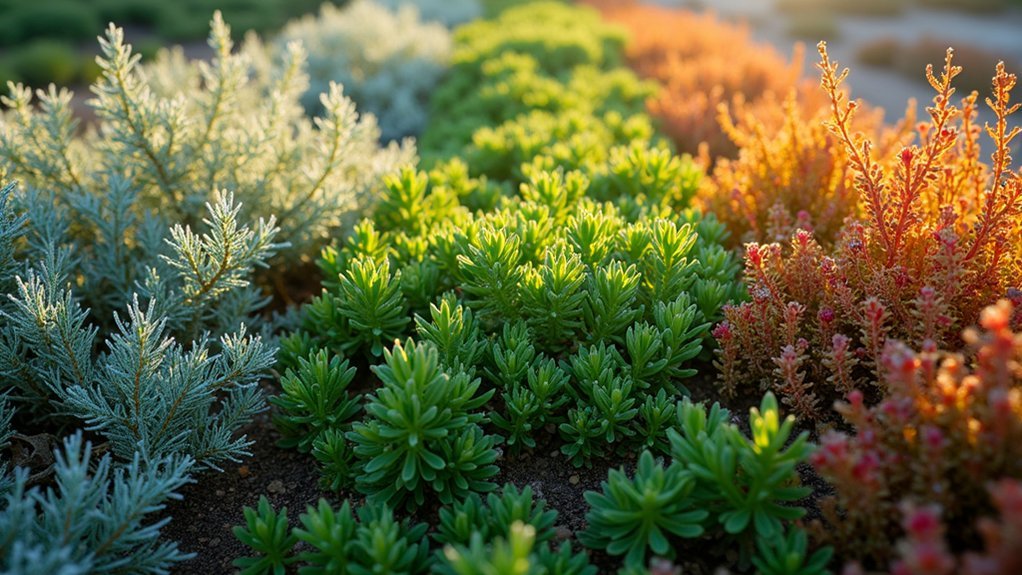Fertilize natural barriers seasonally for ideal growth and protection. Apply balanced NPK fertilizer in early spring, switch to slow-release formulations in summer, and use low-nitrogen, high-potassium options in fall. Don’t forget to mulch 2-3 inches around bases to retain moisture and regulate temperature. For drought periods, reduce fertilizer and focus on deep watering. Tailor your approach to your specific plants and climate zone for stronger, more resilient living boundaries.
Spring Awakening: Kickstarting Growth in Living Fences

As winter retreats and temperatures begin to rise, your living fence requires proper nutrition to thrive during the vital spring growth period. Apply balanced NPK fertilizers in March through early April, giving the plants 2-3 weeks to absorb nutrients before active growth accelerates.
For evergreens, timing is essential as heavy rainfall can leach nitrogen from the soil. Consider garden fertilizers like 10-6-4 or Holly Tone, but use phosphorus and potassium sparingly to prevent environmental issues like algal blooms. Implementing a drip irrigation system will ensure efficient delivery of both water and liquid fertilizers to your living fence.
When selecting plants, incorporate leguminous species like black locust alongside fast-growing options such as hawthorn and blackthorn. These choices not only establish quickly but also support wildlife.
For diversity, add native evergreen shrubs and disease-resistant varieties that’ll require less maintenance while enhancing your garden’s ecological value.
Nutrient Timing for Newly Planted Barrier Hedges
When establishing new barrier hedges, timing your nutrient applications correctly can dramatically impact their long-term health and vigor.
Plant your hedges in autumn or spring when cooler conditions minimize transplant shock.
After planting, water thoroughly and consider adding bonemeal to the soil to enhance establishment.
Apply a balanced fertilizer (10-10-10) in early spring when new growth begins. You’ll typically need just one application annually unless you notice deficiency symptoms.
Don’t overlook the benefits of mulching—it suppresses weeds while retaining moisture and supporting soil health.
Monitor soil moisture regularly and maintain a consistent watering schedule without waterlogging.
Remember that newly planted hedges require about two to three years to fully establish, so be patient and maintain vigilant care during this critical period.
Installing protective guards around plants will prevent damage from animals like rabbits and deer that can severely set back your hedge’s growth.
Summer Feeding Strategies for Dense Privacy Screens

Your summer privacy screen will benefit from a balanced fertilizer that supports dense growth without encouraging excessive, pest-prone foliage.
Plants like Emerald Green Arborvitae that offer both beauty and privacy require specific nutrient management to maintain their dense foliage through summer heat.
Apply slow-release products in mid to late summer, coupled with consistent deep watering to guarantee nutrients reach the root zone effectively.
Mulching around your hedge’s base helps retain vital moisture during hot periods, fundamentally drought-proofing your living wall while maximizing fertilizer efficiency.
Balanced Nutrients, Denser Growth
Creating a lush privacy barrier requires more than just planting and watering—it demands strategic nutrient management throughout the growing season.
You’ll need to balance nitrogen for leafy growth with phosphorus for strong roots and potassium for disease resistance.
Apply fertilizers in light, frequent doses during summer’s active growth period rather than heavy, infrequent applications. This prevents weak, lanky growth that’s susceptible to pests.
Monitor your soil’s pH, as it greatly affects nutrient availability to your plants. Consider creating a continuous planting bed for healthier root systems and more effective nutrient distribution among your privacy screen plants.
Consider incorporating organic compost to improve soil structure while delivering nutrients gradually.
For evergreens like arborvitae or fast-growing vines on trellises, proper feeding guarantees denser foliage and stronger structure.
Remember that overfertilization can be as damaging as undernourishment—follow package directions and observe your plants’ response.
Drought-Proofing Hedge Walls
Summer’s scorching heat can devastate even established privacy screens, making drought-proofing essential for maintaining dense, vibrant barriers throughout the season.
For peak drought resistance, focus on well-adapted varieties like English Laurel for hot climates or Portuguese Laurel for coastal areas. You’ll want to reduce fertilizer applications during extreme heat—instead, apply a generous layer of organic mulch to retain soil moisture and moderate temperature fluctuations.
Established drought-tolerant hedges like Boxwood and Schip Laurel require minimal supplemental watering, but you should monitor soil moisture levels during extended dry periods. Consider incorporating plants like Soft Caress Mahonia that are specifically drought tolerant varieties for challenging conditions.
If you’re planting new sections, choose dense spacing patterns with lavender or other drought-resistant options. Remember that even resilient hedges benefit from occasional deep watering rather than frequent shallow irrigation, encouraging deeper root development.
Drought-Proofing Your Natural Barriers With Proper Fertilization
You’ll protect your natural barriers during drought periods by implementing deep root feeding, which delivers nutrients directly to the root zone where they’re most needed.
Complement this approach with strategic mulching around your plants to improve moisture retention, reduce evaporation, and maintain consistent soil temperature.
These combined techniques create a drought-proofing system that guarantees your privacy screens remain healthy and vibrant even during extended dry periods. Leveraging SoilBeat’s data insights can further optimize your nutrient management planning for more effective drought resistance.
Deep Root Feeding
When natural barriers face drought conditions, their survival depends on the strength and reach of their root systems. Deep root feeding delivers essential nutrients directly to these root systems, bypassing compacted soil and rock ledges that impede growth.
Unlike surface fertilization, this method guarantees long-term nutrient availability with minimal leaching or runoff. You’ll need to take into account your trees’ age, species, and soil conditions before beginning. Spring is ideal for this process, though benefits extend through all seasons.
Professional assistance is recommended, as experts can create customized nutrient blends with proper iron supplements, sulfur additions, and pH adjustments. This attention to detail helps prevent damage to nearby root barrier installations that protect hardscapes from intrusion. They’ll use specialized injection equipment to target the root zone effectively.
After treatment, continue monitoring your barriers, as proper post-fertilization care guarantees peak nutrient absorption and enhanced drought resistance.
Mulch-Based Moisture Retention
While deep root feeding nourishes below the surface, what happens at ground level markedly impacts your natural barriers’ drought resilience. Applying a 2-4 inch layer of organic mulch around your barriers creates a protective moisture shield.
Choose wood chips or bark over rocks for maximum water retention. These materials not only conserve moisture but also regulate soil temperature and suppress competing weeds. Leave a small gap around stems to prevent rot. Water the soil thoroughly before application to establish optimal moisture conditions beneath your mulch layer.
You’ll need to refresh your mulch seasonally—thicker in winter for protection, and replenished in spring and summer for continued effectiveness. The bonus? Organic mulches gradually decompose, enriching your soil naturally.
For enhanced results, incorporate organic fertilizers beneath your mulch layer, creating a complete moisture retention system that supports beneficial soil microorganisms and improves nutrient cycling.
Fall Fortification: Preparing Boundary Plants for Dormancy

As trees shed their leaves and temperatures drop, boundary plants require special attention to survive winter’s harsh conditions and emerge stronger in spring.
Wait until after the first frost to apply fertilizer, focusing on root development rather than new foliage growth.
For deciduous plants, fertilize after leaf drop and use low-nitrogen, high-potassium formulations to enhance winter hardiness.
Apply slow-release fertilizers within the drip line for maximum efficiency. Monitor soil temperature and avoid fertilizing frozen ground. Fall is the ideal season for fertilization as it helps plants build energy reserves for stronger spring growth.
Your soil’s condition matters—amend compacted urban soils with organic matter and balance pH levels before application.
After fertilizing, water lightly to activate nutrients and add 2-3 inches of mulch to regulate soil temperature.
Don’t prune afterward; let plants enter dormancy without additional stress.
Winter Protection for Evergreen Barriers and Windbreaks
Unlike deciduous boundary plants that enter complete dormancy, evergreen barriers and windbreaks face unique winter challenges while remaining metabolically active. Protect these living shields by implementing strategic physical barriers and moisture management techniques.
Before the ground freezes, deeply water your evergreens and apply 2-4 inches of woody mulch to insulate root zones.
- Secure arborvitae, junipers, and yew hedges with cotton strips or bird netting to prevent snow damage.
- Install burlap windbreaks around exposed broadleaf evergreens like rhododendrons to prevent winter desiccation.
- Choose conical-shaped species over wide-spreading varieties to minimize limb breakage from heavy snow loads.
- Avoid late-fall fertilization that might stimulate vulnerable new growth.
- Create temporary shade barriers on sun-exposed sides to reduce winter sunscald on sensitive species.
For optimal wind protection, plant evergreen windbreaks on the north and northwest sides of your property where they’ll be most effective against harsh winter winds.
Organic Approaches to Strengthening Natural Boundaries

Because they work in harmony with nature’s own cycles, organic methods create stronger and more resilient natural barriers than conventional chemical approaches.
You’ll strengthen your living boundaries by implementing crop rotation principles for diverse plantings, which naturally disrupts pest cycles and enhances soil health.
Establish buffer zones of varying widths around your barriers to prevent contamination from neighboring properties. These zones serve double duty by creating wildlife habitat and protecting against drift.
Apply organic amendments to improve soil structure and biology, focusing on building organic matter through mulching and compost applications. Research demonstrates that organically managed soils contain higher organic carbon content compared to conventionally managed soils, providing longer-lasting fertility benefits to barrier plantings.
For climate resilience, keep soil covered year-round with native groundcovers and maintain living root systems throughout your barrier plantings.
This strategy increases carbon sequestration while creating boundaries that can withstand extreme weather events.
Balancing Growth and Density in Mixed-Species Barriers
When establishing natural barriers with multiple species, you’ll need to carefully manage the delicate balance between growth rates and overall density.
Implementing uneven-age management through selective thinning redistributes growing space while maintaining structural diversity. You’ll find that mixed-species barriers offer superior resilience against pests and pathogens compared to monocultures. Be aware that excessive structural diversity may lead to negative biomass changes in your barrier plantings.
- Monitor size-class distribution regularly to prevent dominance of mature stems
- Time fertilization to align with each species’ active growth periods
- Remove smaller, suppressed stems to encourage crown expansion in remaining trees
- Implement variable tree retention strategies to support structural heterogeneity
- Adjust thinning intensity based on seasonal growth patterns and species composition
Regional Adaptations: Fertilizing Living Fences by Climate Zone

Temperate zone fences benefit from early spring and mid-summer fertilization, with 2-4 inches of compost incorporated before planting.
In cool mountainous areas, focus on late spring applications when soil temperatures improve, and include nitrogen-fixing shrubs to compensate for slower nutrient cycling.
For coastal areas, consider fertilizers resistant to leaching from frequent rainfall, while applying mulch helps retain nutrients and protects soil from erosion across all climate types. Species like Gliricidia sepium and Erythrina berteroana provide natural fertilization benefits through their nitrogen-fixing capabilities and leaf litter contribution.
Troubleshooting Nutrient Deficiencies in Boundary Plantings
While adapting fertilization to regional conditions lays the groundwork for healthy living fences, even well-planned boundary plantings can develop nutrient issues that compromise their effectiveness.
Recognizing deficiency symptoms allows you to address problems before they weaken your natural barrier.
- Look for yellowing older leaves with affected veins as signs of nitrogen deficiency; apply animal-based fertilizers to correct.
- Watch for purplish tints on older leaves indicating phosphorus shortage, especially in cold, wet soils.
- Monitor leaf edges for yellowing that progresses inward—a potassium deficiency that reduces drought resistance.
- Check new growth for whitish discoloration suggesting zinc deficiency, particularly in high pH soils.
Regular soil testing provides critical baseline data to determine if visual symptoms are truly nutrient-related or caused by other factors like weather stress or disease.
– Adjust application timing and methods to prevent fertilizer injury while ensuring nutrients reach plant roots efficiently.
The Soil-Barrier Relationship: Building Strong Foundations
The foundation of every successful living barrier begins with understanding the complex relationship between soil and plant life. Your soil type—whether sandy, loamy, or clay—directly impacts how effectively your barrier will establish and function over time.
Success with living barriers depends on understanding soil-plant relationships, as your soil type determines your barrier’s long-term effectiveness.
You’ll find that natural barriers do more than just prevent erosion; they actively improve your soil’s structure as they decompose, contributing valuable organic matter and supporting beneficial organisms like earthworms.
Unlike synthetic alternatives that can block vital airflow and moisture, vegetative barriers maintain healthy soil respiration while stabilizing slopes through their root systems. Natural weed barriers are significantly more eco-friendly gardening practices compared to landscape fabric, which may degrade soil health over extended periods.
Over time, you’ll notice these living barriers can even form natural terraces through sediment deposition, creating a self-reinforcing system that requires less maintenance while continuously enhancing your soil’s fertility and structure.
Wildlife-Friendly Fertilization for Habitat-Supporting Barriers
When you strengthen your natural barriers with wildlife-friendly fertilization methods, you’re not just nurturing plants—you’re creating thriving ecosystems that support local biodiversity.
By testing your soil annually and applying organic alternatives like compost, you’ll provide targeted nutrition while minimizing environmental impact.
Integrate these wildlife-supporting practices into your seasonal routine:
- Apply biofertilizers containing beneficial microorganisms to enhance soil structure and plant health
- Incorporate nitrogen-fixing plants like clover among your barrier vegetation
- Use natural mulch from fallen leaves or grass clippings to improve fertility while providing habitat
- Select diverse native plants that attract pollinators and provide food sources like berries and seeds
- Maintain ideal plant density to create shelter for wildlife without overcrowding
Frequently Asked Questions
Can Fertilization Affect Deer Browsing on Barrier Plantings?
Yes, fertilization increases deer browsing on barrier plantings. You’ll find fertilized plants become more palatable to deer, as they contain higher nitrogen levels and produce tender growth that deer prefer to eat.
How Do Fertilizer Needs Change for Mixed Native and Non-Native Barriers?
You’ll need to balance your approach: native plants require minimal fertilizer while non-natives need more. Adjust seasonally, reducing in summer and winter. Consider using separate zones to meet each plant type’s unique requirements.
Will Excess Fertilizer Increase Maintenance Needs for Living Fences?
Yes, excess fertilizer will increase your maintenance needs. You’ll face more frequent pruning due to rapid growth, additional pest treatments, and potentially replacing damaged plants—all adding to your workload and costs.
Does Mulch Type Around Barriers Influence Fertilizer Efficiency?
Yes, mulch type considerably impacts fertilizer efficiency around barriers. You’ll see better results with black polyethylene mulch compared to organic options like sawdust, though both help retain moisture and reduce nutrient leaching.
Can Fertilizing Barriers Impact Neighboring Vegetable Gardens or Play Areas?
Yes, fertilizing barriers can impact nearby vegetable gardens through nutrient runoff, potentially causing toxicity in crops. It may also contaminate play areas, exposing children to chemicals. You’ll need proper mitigation strategies to prevent these issues.
In Summary
You’ve now got the knowledge to nourish your living barriers year-round. Remember, timing is everything—feed your hedges when they’ll benefit most, adjust for your climate, and watch for signs of nutrient needs. By investing in proper fertilization, you’re not just growing a boundary, you’re cultivating a thriving ecosystem that protects your space while supporting local wildlife. Your living fence will thank you with years of robust growth.





Leave a Reply